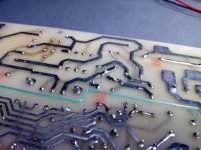DougIngraham
Veteran Member
Thought of something just now related to my Decmate II. I know the monitor gets its power from the host. I do know the monitor powered up and had a cursor. Doesn't this seem to imply that the +12v was working? Never could get the floppy to do anything that I remember. I also don't remember seeing the "Decmate II" message ever being displayed on the monitor. So that seems to imply that maybe the +5v was having problems? The faulty power supply is all in parts right now so I can't verify this.
If you get a cursor on the screen that means the +5 is there as well and at the least the data break part of the 6120 CPU is working. The display memory is just part of the regular memory and the display of characters to the screen is the refresh for the DRAMs. I remember reading somewhere that the CPU loses about 10% of the memory cycles due to the memory reads of the video hardware but loses nothing to refresh because that is automatic. We know that there are 115200 memory references per second due to the display (24 lines * 80 characters * 60 frames.) If each memory reference was 1.5 microseconds then the CPU would lose about 17% to the display. It would be about 12% if each data break is 1 microsecond. All the circuitry to generate the vertical and horizontal sync have to be present or you would not see the cursor (you would see a dot in the center of the display.) The fact that the screen is blank probably means that the CPU wakes up long enough to clear the display memory to blanks. A blank is a 040 code, not a zero so if memory is being read it is reading a 040 and that is being applied to the character generator ROM and you see blanks rather than whatever random code is in memory. With DRAMs, they tend to wake up either all ones or all zeros. It could be that a zero code also displays nothing but that would have been a waste of a character in the ROM. I don't know what the zero code is supposed to display but probably not the same as an ASCII space. Even if they are the same you still know that the 5 volts is enough there to run quite a lot of stuff and the 6120 CMOS CPU is more voltage tolerant than the TTL logic so the CPU is probably running.



